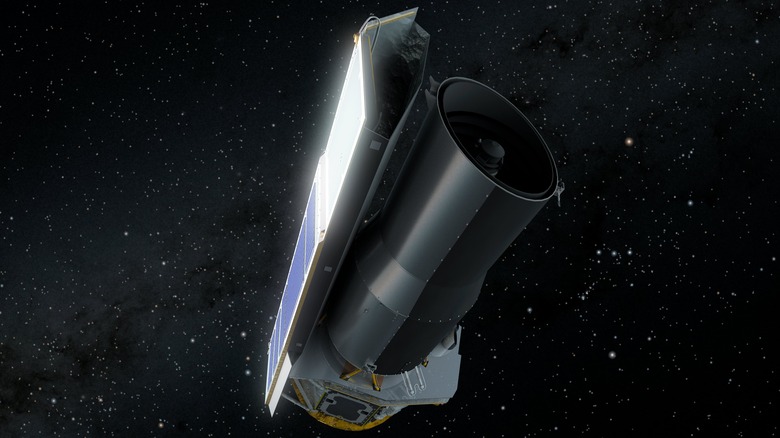Whatever Happened To The Spitzer Space Telescope?
You may not know the name of the Spitzer Space Telescope, but if you like looking at beautiful images of space then you've almost certainly seen some of its images. One of NASA's Great Observatories, four powerful space-based telescopes launched in the 1990s and early 2000s, Spitzer was an invaluable tool for astronomers after its launch in 2003. But in 2020 the mission was retired, and the telescope was deactivated. It's no longer collecting data, and its 16-year mission is now over.
"Spitzer has taught us about entirely new aspects of the cosmos and taken us many steps further in understanding how the universe works, addressing questions about our origins, and whether or not are we alone," said NASA's Thomas Zurbuchen, the associate administrator of the Science Mission Directorate, when Spitzer was retired. "This Great Observatory has also identified some important and new questions and tantalizing objects for further study, mapping a path for future investigations to follow. Its immense impact on science certainly will last well beyond the end of its mission."
Spitzer required a particular type of cooling system for its instruments to operate, and the liquid helium which kept two of the instruments cool ran out in 2009. But the third instrument kept going in what is called an extended mission, in which engineers eked out as much performance and data as they could from the telescope to continue scientific work.
A successor to Spitzer
Spitzer produced some particularly beautiful images of space because it looked in the infrared wavelength, which reveals features that would be invisible in the visible light range. This meant that the telescope could peer through clouds of dust, making it an extremely useful tool for astronomers (via Caltech).
Infrared duties will soon be taken over by the James Webb Space Telescope, launched in December 2021. This telescope is still in the process of getting all its instruments ready for science operations, which are expected to begin in the summer of 2022. When the telescope is ready, it too will look in the infrared and will produce data as a companion to the Hubble Space Telescope (which operates mainly in the visible light wavelength) along with other ground-based and space-based telescopes.
That means Spitzer has its successor, which is one reason NASA chose to retire it. But the legacy of the telescope lives on in all of the data it collected over its lifespan, which is still being used to make scientific discoveries. In the last few weeks alone, data from Spitzer has contributed to finding the most distant galaxy to date, helped reveal surprising facts about hot exoplanet atmospheres, and helped find strange temperature fluctuations on Neptune.
The archive of Spitzer data is publicly available and will continue to contribute to scientific findings.
"We have a huge archive that is waiting to be mined and its revelations already have been tremendous and revolutionary," said Spitzer scientist Farisa Morales in a video commemorating Spitzer's achievements when it retired. "Only time will tell, what is Spitzer's greatest legacy."
